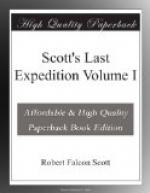To-night it is absolutely calm, with glorious bright sunshine. Several people were sunning themselves at 11 o’clock! sitting on deck and reading.
The land is clear to-night. Coulman Island 75 miles west.
Sounding at 7 P.M., 187 fathoms.
Sounding at 4 A.M., 310
,,
Monday, January 2.—Obs. 75 deg. 3’, 173 deg. 41’. Made good S. 3 W. 119’; C. Crozier S. 22 W. 159’.—It has been a glorious night followed by a glorious forenoon; the sun has been shining almost continuously. Several of us drew a bucket of sea water and had a bath with salt water soap on the deck. The water was cold, of course, but it was quite pleasant to dry oneself in the sun. The deck bathing habit has fallen off since we crossed the Antarctic circle, but Bowers has kept going in all weathers.
There is still a good deal of swell—difficult to understand after a day’s calm—and less than 200 miles of water to wind-ward.
Wilson saw and sketched the new white stomached whale seen by us in the pack.
At 8.30 we sighted Mount Erebus, distant about 115 miles; the sky is covered with light cumulus and an easterly wind has sprung up, force 2 to 3. With all sail set we are making very good progress.
Tuesday, January 3, 10 A.M.—The conditions are very much the same as last night. We are only 24 miles from C. Crozier and the land is showing up well, though Erebus is veiled in stratus cloud.
It looks finer to the south and we may run into sunshine soon, but the wind is alarming and there is a slight swell which has little effect on the ship, but makes all the difference to our landing.
For the moment it doesn’t look hopeful. We have been continuing our line of soundings. From the bank we crossed in latitude 71 deg. the water has gradually got deeper, and we are now getting 310 to 350 fathoms against 180 on the bank.
The Discovery soundings give depths up to 450 fathoms East of Ross Island.
6 P.M.—No good!! Alas! Cape Crozier with all its attractions is denied us.
We came up to the Barrier five miles east of the Cape soon after 1 P.M. The swell from the E.N.E. continued to the end. The Barrier was not more than 60 feet in height. From the crow’s nest one could see well over it, and noted that there was a gentle slope for at least a mile towards the edge. The land of Black (or White?) Island could be seen distinctly behind, topping the huge lines of pressure ridges. We plotted the Barrier edge from the point at which we met it to the Crozier cliffs; to the eye it seems scarcely to have changed since Discovery days, and Wilson thinks it meets the cliff in the same place.
The Barrier takes a sharp turn back at 2 or 3 miles from the cliffs, runs back for half a mile, then west again with a fairly regular surface until within a few hundred yards of the cliffs; the interval is occupied with a single high pressure ridge—the evidences of pressure at the edge being less marked than I had expected.




